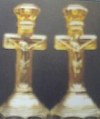Emerald Green Plates
EMERALD GREEN 9” PLATES
Emerald Green, with regard to a color for carnival glass is as subject to personal interpretation as any other matters involving scrutiny with the naked eye. “It's a personal thing.”
Most dark green glass, especially from Northwood production, has a slag effect streak here and there, resulting from a lack of thorough pigment mix. My “personal” interpretation of emerald coloration is attributed to a clear, bright, unblemished green glass, which may or may not have green-looking iridescence, so long as the overspray compliments the base glass. (Now, that's enough said to instigate a controversy, so I will say no more).
In surveying these examples we have presented for you, you can make a comparison of “other greens” and determine for yourself just how much like an emerald cut of natural stone you want your green glass to look! We have been gathering these eight examples over a period of many years………..as we found them pleasing. Not every green plate one encounters, meets our stated specification for emerald green, by any means, and when it involves a Northwood pattern, many of those are not flat enough to suit our tastes, nor do they often possess sameness of coloration around the entire surface of the plate. (We learned that little attribute from John Muehlbauer many years ago!) When a collector once decides how they want their glass to look, then scrutiny is called into play with the search. There is so much more to collecting than simply buying another piece of glass!
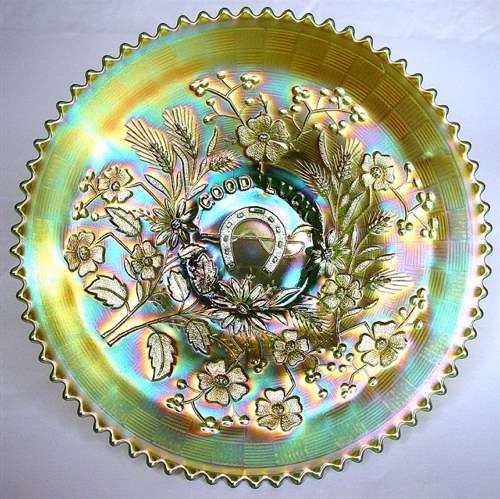
Northwood GOOD LUCK - Basketweave Exterior
GOOD LUCK: plates are much more difficult to locate than the bowls. The extent of known colors is also limited. Then, if you, like we, insist upon flat plates, there are more hurdles to cross, because the majority of Northwood plates are not flat enough to please! We have found that we pass up at least half the plates we see for that reason alone!
Plates are eagerly sought and enjoyed by many collectors, so whatever presents itself easily finds a new home.
The most available colors in this pattern of plate: marigold, amethyst and green, with cobalt blue much more difficult to find. A few examples of horehound and Renninger blue exist. The most expensive and most difficult are the ice blue and ice green plates. Fewer than half dozen each are known. It takes serious money to obtain either of those colors.
If you insist upon stippling, the only reported colors are marigold, amethyst, cobalt blue and Renninger blue. All are quite rare.
Good Luck plates measure about 9 ½” in diameter. This particular one was purchased from a Seeck Auction in St. Louis when Charlotte and Gordon Williams of Northern CA. sold the last of their collection in the late `90s. Charlotte was the very gracious lady who loaned us her Butler Brothers Catalogs-along with Frank M. Fenton, when we produced the Reprints in 1994.
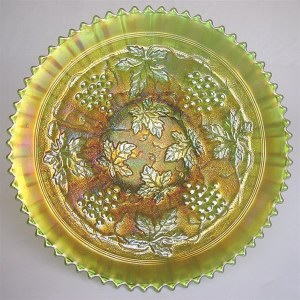 |
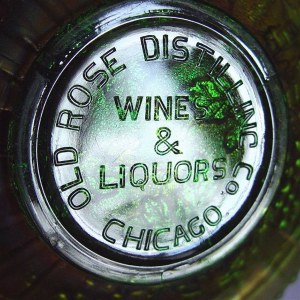 |
Northwood STIPPLED GRAPE & CABLE - Ribbed Exterior
|
OLD ROSE DISTILLING Advertising within marie (collar base) of Stippled Grape & Cable Plate
|
GRAPE & CABLE: plate in what is called a “variant”. Notice the vine tendrils which trail in toward the center? The bunches of grapes on these pieces are said to be less triangular than on the regular Grape and Cable design. However, it is the rings around the design, along with the stippling which help define the variant label, as well. Inside the collar base or marie on the reverse side: OLD ROSE DISTILLING Co. Chicago - Wine and Liquors printing, places this plate in the Advertising category of specialty pieces. This green plate is the only color and style which was used for that purpose. They are not especially rare, but should be considered somewhat scarce. This plate was purchased in July 2004 from a Wroda Auction when Alma Ricketts sold the last of her more than 30 year collection.
Note: When searching for a stippled piece of glass, the price is usually somewhat more than for an unstippled example in the same pattern. In many cases, the circle of three raised ribs around the design has almost completely faded from view during production process. In other examples, the rings or ribbing is only partially visible. Since that encirclement is part of the attraction to these pieces, you will no doubt discover that in the process of looking for “your” chosen piece, you will pass up some examples before finding one with complete rings. Patience over time is called for.
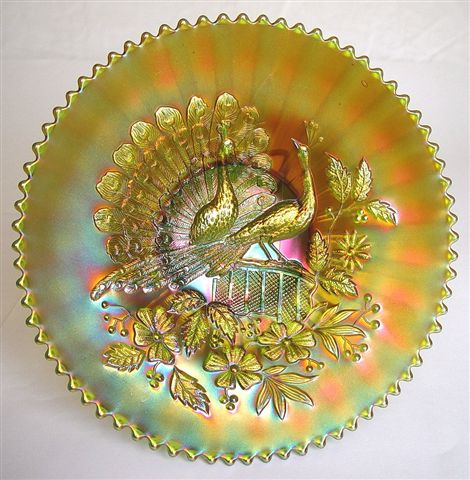
Northwood PEACOCKS - Ribbed Exterior
PEACOCKS: plates measure 9”-9 1/2” depending upon their “flat attitude”, and may be found with plain, ribbed, or basketweave exteriors. The ribbed design seems to be found most often, and found in more colors. Marigold, amethyst, cobalt blue, white, and the ice green plates are more plentiful than other colors! Have you ever pondered that fact?
Ice green Peacocks plates (Northwood) were “suspect” when we actively came into CG circles in about 1980. During an ICGA convention held in St. Louis, knowing we were new collectors at the time, a man by the name of Wesley Strain of St. Louis showed us a lovely (damaged) ice green Peacocks plate which was much more of a mint green than any of the ice green plates found regularly for sale! He went on to explain that a man had borrowed his plate under pretense. When it was not returned in an appropriate period of time, Wes went looking for the man. He found a shop of sorts, set up in a garage against an alley in old St. Louis (this was in the mid-70s). A “number” of ice green Peacocks plates had been and were being made there, having used Wes' old plate for pattern duplication. Of course Wes took his plate home with him, but the harm had already been committed!
At the time we heard the story, we already owned one of the newer plates. Wes gave us his old glued (in three places) example to take back to San Diego for comparison. (We later returned it to him.)
Sure enough, when the old and the newer are seen together, there is a very definite difference in the base color, along with the weight of the glass, and the depth of the pattern press. The “catch 22” here, is that there are so FEW of the OLD MINT GREEN examples, that we are never afforded the opportunity of comparison!! Some of the newer ones we have seen over the years have had zillions of teeny-tiny bubbles within the glass, especially when held against light; whereas, the bubbles evident in the old glass are usually only one or two and of a larger size.
When we discussed this matter at Club meetings in Los Angeles, it was scoffed at by many. Even then, collectors did not want to believe that such activity had taken place.
The fact remains, that from the `80s to today, when one of those ice green Peacocks plates surfaces at an auction, or wherever it appears for sale, the price has remained about the same - roughly $375 - $500 at most. THINK about that if you will! What other ice green plate sells for so little?? Is it a matter of delusion, or do we subtly and inwardly suspect there is an unknown factor surrounding this plate?
The next question one must ask is: “Why are there so many of that pattern in ice green?” Simple explanation is this: pastel glass is the easiest to mix when trying to create a bogus example and at the time those were being made in a garage operation, the light, pastel iridescence was available in all pottery supply stores! -
Today, that toxic spray remains available in the Orient, where considerable numbers of American molds have gone.
On with my explanation: Lavender and green Peacocks plates are quite scarce and ice blue examples are very scarce. Rarer still are the smoke, horehound and Renninger blue plates. There is a single known rare sapphire plate. Stippled examples have been documented in four colors to date: marigold, cobalt blue and Renninger blue, and amethyst. The electric amethyst example brought $2800. when it surfaced in 2002.
Our plate was purchased from an auction some years ago when John & Lucile Britt began selling off their vast collection. We enjoy the idea that the appearance of the sun is rising over the Peacocks.
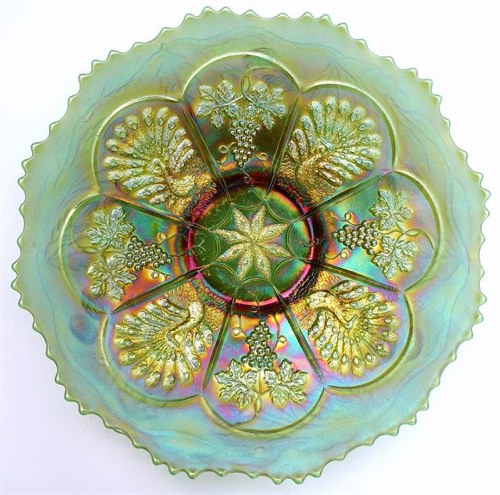
PEACOCK & GRAPE
PEACOCK and GRAPE: plates from Fenton are very desirable items. We believe you will agree that this one meets the criteria (emerald green) quite handsomely. Fenton possibly made fewer examples of green than Northwood. There is certainly less of it than blue base glass from this manufacturer. On the other hand, Northwood created fewer patterns in blue.
We did not buy this plate until 2000 while attending the Tampa Bay Carnival Glass Convention that year. At that time there were only two others known in green. Since that time another has surfaced. Fenton plates in all sizes are much more flat than those from Northwood. With possible exception to plates from Imperial, Fenton leads the parade of nice, flat plates.
Peacock and Grape was extensively manufactured in various shapes and colors. Just why there are so few green examples in the plate shape is a mystery. Amethyst, blue, electric blue, green, and marigold examples are known in 9” plates with collar bases. These have Bearded Berry exterior.
Spatula footed 9” plates are also found in amethyst, blue, green, teal, and marigold. The exterior on these can either be plain or have the Bearded Berry pattern.
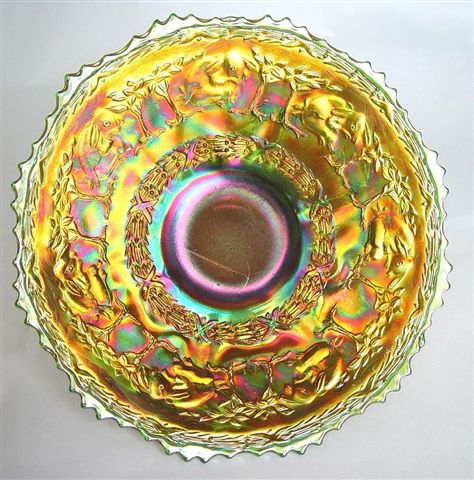
Fenton PETER RABBIT- Bearded Berry Exterior
PETER RABBIT: plates are of the 9” size and considered rare in any of the three colors known! We recall a beautiful marigold example which sold many years ago for $8000; before that was a more common selling price for any piece of carnival glass. It went to a mail bid from a Seeck Auction. There seem to be fewer of that color than blue or green.
Another interesting point about these plates: many of the green and blue ones come back to the United States from England and Australia, indicating those countries to have been the prime original market. These have the Bearded Berry exterior, which Fenton is famous for. Some plates we have seen carry what are referred to as acid spots; places where the overspray may have landed on the surface of the plate in a “blob” of one color or another. Not all of the blue and green plates are as “glorific” as the one you see here. Some blue plates are quite dark in color, actually. This particular plate came from Richard Cinclair, by way of an ICGA Club Auction some years ago. I remember standing up with a shout of joy at winning the bid! We had tried at other times to get one, but this is prettier than any of the others we have seen, so it was worth waiting for!
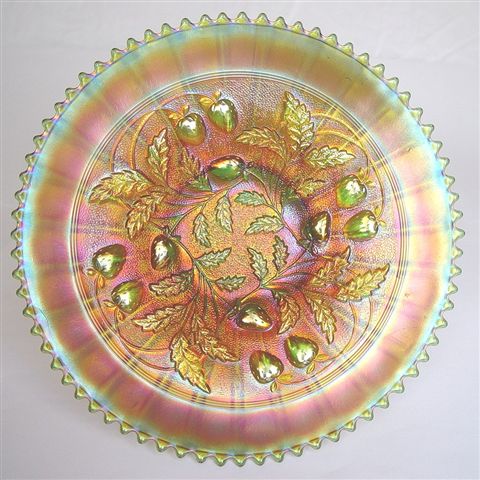
Northwood STIPPLED STRAWBERRY - Ribbed Exterior
STRAWBERRY: stippled plates are found in marigold, amethyst, green, cobalt blue, ice blue and ice green. Even the most available color on these stippled versions, amethyst, is not easily found. They are very rare in green, cobalt blue or marigold. Top honors go to the ice blue examples. They will bring staggering prices. One sold over E-bay in 2003 for more than $16,000. A spectacular ice green example brought $15,500 in 2000. Either Ribbed or Basketweave can be found on the exterior of these plates. We purchased this example from a Reichel auction in 2004. There are white stippled bowls in Strawberry pattern, but no plates have been found.
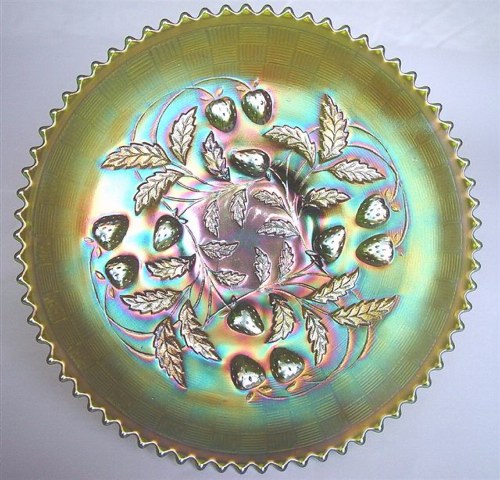
Northwood STRAWBERRY - Basketweave Exterior
STRAWBERRY: unstippled plates usually have the Basketweave exterior. Marigold, amethyst, green, lavender and very rare peach opalescent are the colors known for this version. The opalescence is said to be light on all three known plates in peach, confined to only the fluted edge points, but this is a rare color for Northwood. Amethyst, marigold or green plates are fairly available. Lavender is scarce.
The trick in locating a great Strawberry example is in finding strawberries with their seeds intact, and covered with iridescence. Throughout the years, wear has eliminated both in many cases. Since “iridescence is the essence” of carnival glass collecting, striving for the best examples available becomes a priority. The plate we show was purchased from an E-bay seller, and we believe it to be a choice plate.
Conclusion: During our more than 30 years of collecting sound, “unaltered” carnival glass plates in chop size, 9”, and small sizes, we have purchased more Fenton plates than any others, simply for their flat status, which we enjoy. We can tell you unequivocally that of those more than 100 plates, we have NEVER owned one which resembles an egg plate, with dips on the surface from re-heating a former bowl and having weird tool marks left on the exterior in an attempt to produce a “first one known”………………in ANY color!
NOTE**** Fenton produced truly flat plates in all sizes with perfectly straight edges.
We have seen and handled some questionable “plates”, and watched others purchase them, certainly.
We do not buy other than the “real McCoy”.
We have been skeptical about “first knowns” for at least 15 years now, not really eager to throw money away.
Dean & Diane Fry - 6-05

And take not the word of truth utterly out of my mouth, for I have hoped in Your ordinances.
So shall I keep Your law continually, forever and ever.
And I will walk at liberty, for I seek Your precepts.
I will speak of Your testimonies also before kings, and will not be ashamed.
And I will delight myself in Your commandments, which I love.
My hands also I will lift up to Your commandments, which I love, and I will meditate on Your statutes.
______Psalm 119: 43-48

Should you care to contact the Frys, their email address is:
Search Our Sites
back to Carnival Glass 101
Our other sites you may enjoy:
Everything you EVER wanted to know about Indiana Glass
Great Reference for Newer Carnival Glass.
Complete Glassware Catalogs Available to Download
Questions? Comments? Suggestions? Broken Links? Corrections?
Your Friendly Webmaster is here to help!
